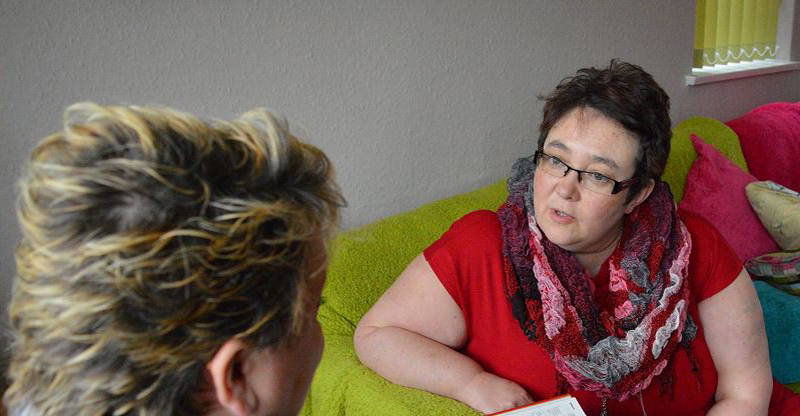As a psychotherapist who is also a fat woman it did not previously occur to me how my size and that of my clients impacted on the work we did together. Size is hardly ever considered as an aspect of diversity, except in the size acceptance and fat activist communities. My perspective changed when I read ‘Health at Every Size’ by Linda Bacon and ‘Body Respect’ by Linda Bacon and Lucy Aphramor. These books and other critical perspectives opened my eyes to the ways in which larger people, including myself, are marginalised because of their size. This ultimately led me to my current research drawing on clients’ and therapists’ experiences which support the development of size affirmative practices in psychotherapy and counselling.
The below points represent some of the key learning from my own journey and research, which I am keen to share to help support you if you are a larger client, or a therapist who is working with one.
1: Should we talk about size/weight in therapy?

There is no reason why weight should not be a legitimate topic in psychotherapy and counselling if the client initiates the conversation. However, it is very important to acknowledge the implicit bias we hold as a result of toxic diet culture and the rhetoric of the (So Called) Obesity Epidemic (SCOE). Checking our assumptions about the taken for granted links between size and ill health, as well as critiquing the derogatory stereotypes of larger people we are presented with on a daily basis can help to focus on the central issues in therapy as they are perceived by the client. We can then work with each client on how (and indeed if) weight relates to these.
Having said this, it is important to see weight as just one aspect of a complex profile of diversity which means clients (and therapists) experience varying amounts of marginalisation and privilege. Gender, sexuality and relationship diversity, ethnicity, disability and social status among other things all contribute to how the client is viewed and treated.
2: Does being a higher weight impact on wellbeing?

The short answer to this is yes! But not in the way you might expect. A number of critical studies dispute commonly held assumptions such as the fact that our weight is in our control, and that there are causal links between size and physical and psychological ill health. What larger people do experience is the daily stigma of being told their bodies are not aesthetically worthy, and that they take up too much space. Take the phenomenon of the ‘Headless Fatty’ as an example (Cooper, 2007). This is where photos are taken of people of size without their consent and presented only from the neck down which dehumanises the subject. Many studies into weight stigma focus on how it impacts on weight and eating behaviours, rather than its long term psychological impact. If we consider social determinants of health more widely, we are presented with evidence that the stigma and marginalisation fat people face has a significant impact on their health.
3: What words should I use about my client’s size?

In my recent research the most common word participants used to describe themselves was ‘Fat’. This represents a move to the word being reclaimed as a descriptor of size rather than the insult it has come to represent. Other words used were ‘plus-sized’, ‘big’, ‘chunky’ and a plethora of other terms. It is important to reflect and honour the language your client is using in relation to their size. At the same time it is worth considering the implicit meaning in terms such as ‘overweight’ and ‘obese’ as representing deviation from a largely unachievable norm of Body Mass Index (BMI).
4: What if my client wants to lose weight?

Of course, client autonomy and self-agency is paramount. However, studies suggest that only 2-5 per cent of dieters maintain long term weight loss. Clients may not be aware of alternative approaches to wellbeing such as Health at Every Size (HAES) ™ and Well Now. These approaches advocate for a holistic approach in which food and movement are only two of a wide range of factors which impact on wellbeing. These approaches acknowledge the contribution of factors such as marginalisation, weight-stigma, poverty and trauma on health. They discourage intentional weight loss and suggest that a person will reach a ‘settling point’ weight if optimum conditions exist for their wellbeing. Importantly, this settling point is unique to the individual and may not conform to what is deemed ‘normal’ on a BMI scale. Holding an awareness of such approaches can support you to explore with clients the range of options open to them in their wellbeing journey. This may mean exploring internalised weight stigma and challenging the societal assumption that wellbeing is not possible in a larger body. Participants in my recent study reported that unsolicited suggestions of weight loss by their therapists were unhelpful.
5: I am a client/therapist and I want to learn more – where can I look?

The below resources will be useful for therapists wishing to develop a size affirmative practice and for clients wanting to know more about the approaches mentioned in this article.
- Health at Every Size by Linda Bacon and Body Respect by Linda Bacon and Lucy Aphramor are excellent introductions to alternative approaches to wellbeing which challenge the taken for granted, causal links between size and ill health. You can learn more about Lucy Aphramor’s ‘Well Now’ approach (offering workshops for both clients and wellbeing practitioners) on her website.
- There is a Health at Every Size UK website with links to practitioners working from the HAES approach. The US based Association for Size Diversity and Health (ASDAH) and the National Association for the Advancement of Fat Acceptance (NAAFA) may also be of interest.
- Fat Lives by Irmgard Tischner is a research based study which can give insight into how larger people experience living in a fatphobic society.
- You can read more about the ‘Headless Fatties’ phenomenon at Charlotte Cooper’s website here.
- Esther Rothblum’s paper Slim chance for permanent weight loss explores some of the reasons why psychological wellbeing professionals may perpetuate some of the myths presented by diet culture.
- You can learn more about my ongoing research into size affirmative therapy at sizeandtherapy.com.





Rate and Review
Rate this article
Review this article
Log into OpenLearn to leave reviews and join in the conversation.
Article reviews